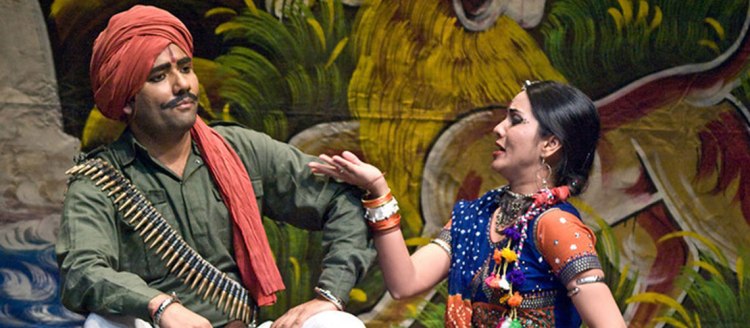Fresno State communication professor Dr. Devendra Sharma recently started rehearsals of his groundbreaking show “Princess Nautanki,” a traditional performance that uses a contemporary, women-centered lens. The production follows a princess who breaks tradition by choosing to marry a commoner, something the king vehemently prohibits. The story explores her resistance to her father’s wishes, even including a sword-fighting scene between her father and her.
“It is important because women’s role in India, as well as in the United States and everywhere else, is changing,” said Sharma. “I really wanted to include this story because the key character herself is so confident.”
Nautanki is a style of traditional North Indian opera. Sharma said it was the most popular entertainment medium in the region until the advent of Bollywood, which took considerable inspiration from the nautanki art form.
Traditionally, nautankis occur in any available open space in or around a village. The stage is elevated above the ground and is usually composed of wooden cots with a cloth backdrop. But even a small platform of bricks in front of a house can serve as the stage. Musicians and percussionists sit on one side, and actors and singers occupy the center stage. The main instruments used include the harmonium (reed organ), nakkara (drum) and dholak (two-headed hand drum).
These humble beginnings reflect the accessibility of nautanki. Though the shows usually cost a fee, villages can use alternate ways to pay if they cannot afford the traveling operas, such as providing food or other goods.
Sharma is a seventh-generation nautanki performer, writer, director and guru and has acted in more than 500 plays. His family were farmers that became renowned for their nautanki renditions because of their proficiency in musical instruments and performance. Sharma’s father and teacher, Pandit Ram Dayal Sharma, was the 2014 Sangeet Natak Akademi Award recipient by the president of India and is one of the country’s most well-known nautanki performers.
Nautankis in India often begin at 10 p.m. and end at sunrise, though Sharma’s “Princess Nautanki” has an approximate runtime of two and a half hours.
Scenes from the larger performance of “Princess Nautanki” recently debuted in Piedmont and were well received. The whole show will be performed in various venues around the Bay Area, including Duke Street in San Francisco, as a part of CounterPulse. This diaspora-centered organization has been significant in the San Francisco performance art scene since the 1990s.
Since the early 2000s, Sharma has been on the vanguard of bringing the art form to the United States. Sharma’s “Princess Nautanki” will be the largest nautanki ever performed in the United States.
The manifestation of culture and societal movements, an important element of nautanki, is evident within “Princess Nautanki,” notable for being a contemporary spin on a 19th-century story. The tale follows a princess standing up to her father, the king, displaying a strong, defiant and subversive female protagonist.
“But now more and more women are coming out. Women have found a different kind of confidence in their voice. And that’s why I want to bring in a character from today’s time that is telling the story or retelling the story of the nautanki princess of the 19th century.”
Sharma’s “Princess Nautanki” production delves into ideas of love, gender roles, tradition, change and more to reflect the evolving cultures of India and America. From Gandhi and Indian independence to growing sentiments against child marriage in the early 1900s, Sharma notes nautanki’s position as a voice of the people.
“It absorbs what audiences demand,” said Sharma.
As a professor, he has brought the art form to his classes, having students create performances reflective of nautanki that include their own personal and cultural influences.
“Sometimes they would use rap, sometimes hip hop, sometimes even country music and rap battles, you name it. Then they would also be interested in some kind of singing from nautanki, so they would take two lines from nautanki but rewrite it in English.”
Following the Bay Area run, Sharma said he wants to bring the performance to Fresno State.
The “Princess Nautanki” project was made possible by a $150,000 grant to Sharma from the William and Flora Hewlett Foundation. The foundation says that its overall $8 million commitment nationally is the largest ever to the folk and traditional arts.

